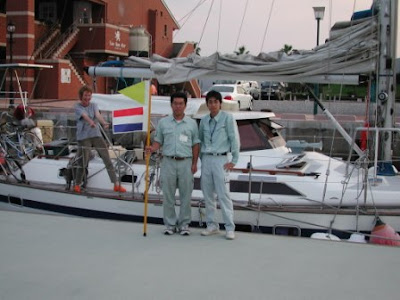We left Fukuoka on September 20th, a little later then planned due to our upcoming residency status, which after 6 month still wasn’t decided, and once we got those stamps in our passport, typhoon nr 13 (Shanshan) paid us a visit. Luckily that was the only typhoon that bothered us on our way south, that means UNTILL we were in Japan’s last harbor, Ishigaki.
But
first things first. Our first stop was in the most uninteresting
Why did we go there? Because we wanted
to sail in the Goto Retto island group and we needed a cruising permit. Foreign
yachts can visit any “open port” at any time, but need cruising permits with
strict itineraries for other places. These permits, necessary for each
prefecture, can be obtained from a Ministry of Transportation office in that
prefecture, usually located in these open ports. But there was no such office
in Imari. Jaap just checked in with customs who told us to go to
Around
the corner of Kuyshu’s NW point lies Hirado. An idyllic town worth a visit if
only there was room for a 43ft yacht. We
had stopped there on our first run in
Now, where??? should we go??? There was lots of big ship traffic around us. We were dodging them this way and that, discussing the possibilities, when a little Sasebo Port Control boat drew up behind us and a man pointed his finger to a little pontoon. There, to our big surprise, where 2 uniformed officials, waving 2 flags, one yellow and the other the Dutch red, white and blue! Apparantly Imari had phoned, so they prepared this little welcome for us. Jaap asked if they did this for every foreign yacht, but no, we were the first.
They
took Jaap to clear in and see the Transportation Office people. Our plan of
just getting the permit and sailing out again was not feasible; it doesn’t seem
to be possible to issue a permit in a few minutes. Jaap had to come back the
next day after lunch. In the meantime we could stay on this private little
pontoon.
By
now the fact that we had left
So we changed course, sailed under these 2 bridges through this narrow passage (timing it well as the current runs up to 10 knots), and ended up in HtB.
Huis
ten Bosch, a little piece of the
Scenes
of Huis ten Bosch: The
Flower-power
Henk on one of his specials
In
the yacht harbor we met some other live-aboards, it was great to talk to them.
In
The HtB yacht harbor from the “Dom tower”
Just
when the weather was getting better and we were planning to move on, an old
friend stopped by. Jan from
Interview with Floortje.
And then the day came we finally left for the Goto.Retto We had given up on that most northern place, the fisherina on Uke and headed straight for Nama. The town had changed little. We had been there 17 years before during a summer festival and it was noisy and lively then, but now the place was dead quiet. We kept some photos of that time and showed them to the people who dropped by. “All the young men have left” they said, “looking for better jobs in the cities.” But what hadn’t changed was the hospitality and generosity of the people. We got loaded with potatoes, onions, rice cakes and cookies.
The next day we sailed to Wakamatsu. The winds were light again and we motor-sailed between the islands, enjoying the scenery.
Alishan in Wakamatsu
What
we still missed was decent fishing gear, so in Wakamatsu we took out some gift
envelopes that we got in
Look at his grin!
When
we got into the
The first day Nori hurt himself when he made an unauthorized and uncontrolled jump for freedom ashore. The scratch needed stitches badly! We asked the lady at the front desk of the inn where to go and she kindly lent us her car. Nori was fixed in no time, but needed to rest, so we stayed a whole week. And that was a week of walking, cycling, running and eating fish, fish and more fish. Mainly squid and mainly raw.
Ikezukuri,
the best way to eat raw squid, prepared onboard by a local fisherman.
Thanks guys!
Something else, very tasty on these islands:
Sea urchin eggs on top of a bowl of rice, accompanied by a sweet pickle, fried or baked fish, miso soup and cups of green tea. The yellow stuff is pickled radish, good for digesting all that good food.
























No comments:
Post a Comment